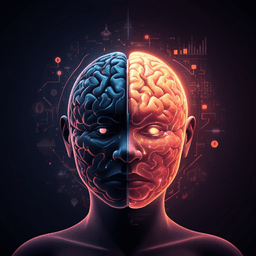
Psychology
The complexity of the stream of consciousness
P. Coppola, J. Allanson, et al.
Unlock the mysteries of consciousness with groundbreaking research by Peter Coppola, Judith Allanson, Lorina Naci, and their colleagues. This study integrates modern theories and phenomenology, revealing how consciousness is linked to unpredictable yet constant dynamics in brain connectivity. Dive into a richer understanding of the mind's landscape!
~3 min • Beginner • English
Introduction
The study addresses how to objectively characterize subjective conscious experience by linking dynamic functional connectivity (FC) patterns to the stream of consciousness. Prior work shows that FC networks correlate with mental content and disintegrate with unconsciousness. The authors posit a stable mapping between connectivity states and experiential states and propose an intrinsically defined, individual-specific representation of dynamic connectivity (a "Meta-Matrix") that captures each state's relationship to past and future states. They hypothesize that consciousness entails short-term transitions that are faster, less predictable, yet more constant, and that the distal, longer-term state-space is more complex. They also predict greater dynamical freedom of FC relative to structural connectivity in consciousness. These hypotheses are tested across healthy controls (awake, sedation), patients with minimally conscious state (MCS), and unresponsive wakefulness syndrome (UWS), with replication in an independent propofol dataset and subsystem analyses (cortex, subcortex, cerebellum).
Literature Review
Contemporary theories (Integrated Information Theory, temporo-spatial theory, entropic brain hypothesis) emphasize functional relationships, integration, and spatiotemporal organization as bases for consciousness. Empirical work links FC patterns to cognitive states and shows network disintegration with anesthesia and disorders of consciousness. Dynamic FC studies using clustering report richer repertoires during consciousness, but averaging across individuals obscures individual temporal unfolding. Structural-functional coupling increases under anesthesia and deep sleep, suggesting reduced functional freedom. The present work advances by analyzing individual-specific, non-clustered intrinsic dynamics and their relationship to structure, aligning with dynamical systems and phenomenological perspectives.
Methodology
Design and datasets: Resting-state fMRI datasets included: (1) Cambridge anesthesia dataset: 18 healthy adults with awake control and moderate propofol sedation (TR=2s, 5 min per condition); (2) Disorders of consciousness (DOC): 23 patients (11 MCS, 12 UWS; TR=2s, 10 min); (3) London, Ontario (LON) propofol dataset: 16 healthy adults with awake, mild, and deep sedation (TR=2s, 8 min) for reproducibility. Diffusion-weighted imaging (DWI/DTI) was available for DOC patients and a separate sample of 18 healthy controls.
Preprocessing: fMRI preprocessing via SPM12 and CONN: remove first 5 scans, slice-timing correction, realignment, normalization to EPI template, nuisance regression (motion, 5 WM/5 CSF PCA components), ART artifact rejection, linear detrending, band-pass 0.008–0.09 Hz (alternative pipelines included global signal regression, high-pass only, and instantaneous phase synchrony). DWI preprocessing with MRtrix3 and DSI Studio; deterministic tractography (1,000,000 streamlines per subject). Parcellations of varying granularity covered whole brain and subsystems (cortex, subcortex, cerebellum).
Dynamic connectivity and Meta-Matrix (MM): Time series were segmented with a 24-TR sliding window advanced by 1 TR, with Gaussian tapering. Within each window, FC matrices (region-wise Pearson correlations) were computed, producing time-varying FC. The MM is the similarity matrix (Pearson r of vectorized upper triangles) between all FC matrices, ordered in time. A Temporal Decay of Similarity Model (TDSM; linear and exponential) was constructed to model monotonic similarity decay with temporal distance.
Proximal dynamics: From the first sub-diagonal (successive time points, 2s apart) of the MM, a time series of short-term FC changes was derived. Metrics computed: central tendency (median), variability (standard deviation; confirmed with Shannon entropy), and temporal complexity (sample entropy; replicated with Effort-to-Compress, ETC). Sensitivity analyses averaged across further sub-diagonals up to 26s.
Distal dynamics: To assess longer-term state-space properties, proximal autocorrelations were removed by excluding 13 or 24 nearest diagonals, yielding a distal Meta-Matrix (dMM). For each column (a given FC state's similarity to distal states), complexity metrics were computed (sample entropy, ETC) and averaged across columns; central tendency and variability were also assessed.
Structure-function dynamics: For each FC state, similarity (Pearson r) to the individual’s structural connectivity matrix (DTI-based) yielded a time series of structure–function coupling. Its complexity (sample entropy, ETC) was computed for whole brain and subsystems.
Statistics: Ordinal logistic regression (OLR; MASS::polr) tested whether metrics scaled with ordered levels of awareness (control > sedation > MCS > UWS, or control > MCS > UWS where applicable). Model assumptions (proportional odds) and multicollinearity were checked; robustness assessed across parcellations, preprocessing variants, alternative distance metrics (Manhattan, cosine), and replication dataset (LON).
Key Findings
- Predictability of intrinsic dynamics: MM similarity to the TDSM increased with decreasing awareness (Odds Ratio [OR]=3.17, p=0.0001), robust across TDSM variants, parcellations, datasets, and preprocessing (except with high-pass only).
- Proximal (2s) transitions:
• Average rate of change: Unconsciousness showed higher short-term similarity (slower change) (OR=4.06, p=0.0002), prominent in deep anesthesia and UWS.
• Variability of rate of change: Standard deviation decreased with higher awareness (OR=3.50, p=0.00001), indicating more constant rates of change in consciousness; highly correlated with mean absolute derivative (rho=0.84).
• Temporal complexity: Sample entropy of proximal transitions increased with awareness (OR=4.41, p=0.000006), indicating less predictable moment-to-moment transitions.
- Distal state-space:
• Average/variation of distal similarities showed no appreciable group differences.
• Complexity (compressibility) of dMM columns scaled with awareness (ETC OR≈5.5, p≈3–4e-5), indicating distally defined states are less compressible (more complex) in consciousness.
- Subsystems (Table 1 examples): Cortex and subcortex showed high effect sizes across measures; cerebellar effects were weaker/liminal. For dMM ETC: cortex OR=6.60 (p=0.000002), subcortex OR=3.98 (p=0.000013), cerebellum OR=2.14 (p=0.09). Proximal sample entropy: cortex OR=3.24 (p=0.000161), subcortex OR=2.55 (p=0.000015), cerebellum OR=2.58 (p=0.09).
- Independence of measures: Proximal and distal metrics were intercorrelated (average shared variance ~22%); joint OLR suggested partial independence in some analyses (e.g., dMM compressibility OR=3.82, p=0.0004; proximal SD OR=1.93, p=0.02) but not unequivocally across permutations.
- Structure–function dynamics: Complexity of the time-varying similarity between FC and structural connectivity increased with awareness.
• Whole brain: OR=2.95, p=0.002.
• Cortex: OR=5.42, p=0.003; Subcortex: OR=3.84, p=0.0004; Cerebellum: OR=3.36, p=0.001. In joint models, cortex (p=0.01) and subcortex (p=0.0003) retained independent predictive power; cerebellum did not (p=0.07).
• Max structure–function similarity tended to be higher in DOC vs controls (some contrasts significant but not after multiple-comparisons correction), suggesting reduced functional freedom in DOC.
Overall, consciousness is associated with faster but more temporally constant and less predictable short-term FC transitions, increased distal state-space complexity, and greater dynamical freedom from structural constraints.
Discussion
Findings support that conscious brain dynamics exhibit structured complexity: moment-to-moment FC transitions are faster and less predictable yet maintain a relatively constant speed, while the longer-term positioning of states in intrinsic state space is more complex. The stronger complexity of structure–function coupling dynamics indicates greater freedom for FC to deviate from anatomical constraints during consciousness, enabling a richer repertoire of states. These results align with temporo-spatial theories, the entropic brain hypothesis, and ideas of metastability, suggesting a flatter but locally intricate dynamical landscape in consciousness. Subsystem analyses indicate substantial contributions from cortex and subcortex, with cerebellum showing some consciousness-relevant dynamics. The work bridges dynamical systems and phenomenology by constructing individual-specific intrinsic landscapes that may proxy the evolving stream of consciousness.
Conclusion
The study introduces an intrinsically defined, individual-specific dynamic connectivity framework (Meta-Matrix) to characterize the stream of consciousness. Consciousness is marked by short-term FC transitions that are faster, less predictable, and overall more constant, and by a distal state-space that is harder to compress. Functional dynamics are less tethered to structural connectivity in consciousness, across cortex and subcortex (and to a lesser extent cerebellum). This approach provides a principled means to quantify individual dynamic landscapes and may form a bridge between dynamical systems accounts and subjective phenomenology. Future work could integrate experience sampling or naturalistic paradigms to map content, combine with clustering to characterize specific states’ dynamics, and use higher-temporal-resolution data to resolve fine-grained individual trajectories.
Limitations
- Content not assessed: Resting-state design and intrinsic definitions preclude identifying the specific contents of conscious experience; the approach proxies dynamics rather than content.
- Preprocessing dependencies: Some effects (e.g., cortical proximal measures) were sensitive to preprocessing choices such as global signal regression or high-pass filtering (which attenuated TDSM effects).
- Measure interdependence: Proximal and distal metrics are correlated; evidence for independent predictive power was not unequivocal across all control analyses.
- Multiple comparisons: Some secondary tests (e.g., max structure–function similarities) did not survive correction.
- DWI heterogeneity and availability: Two DWI acquisition schemes in DOC; propofol control cohort lacked DWI (separate control sample used). Results were generally robust but these factors may limit generalizability.
- Sample size and coverage: Moderate cohort sizes; incomplete cerebellar coverage excluded one UWS from cerebellar analyses.
- Modeling simplifications: TDSM provides a simple monotonic model; true dynamics may involve returns/recurrences not captured by this benchmark.
Related Publications
Explore these studies to deepen your understanding of the subject.







